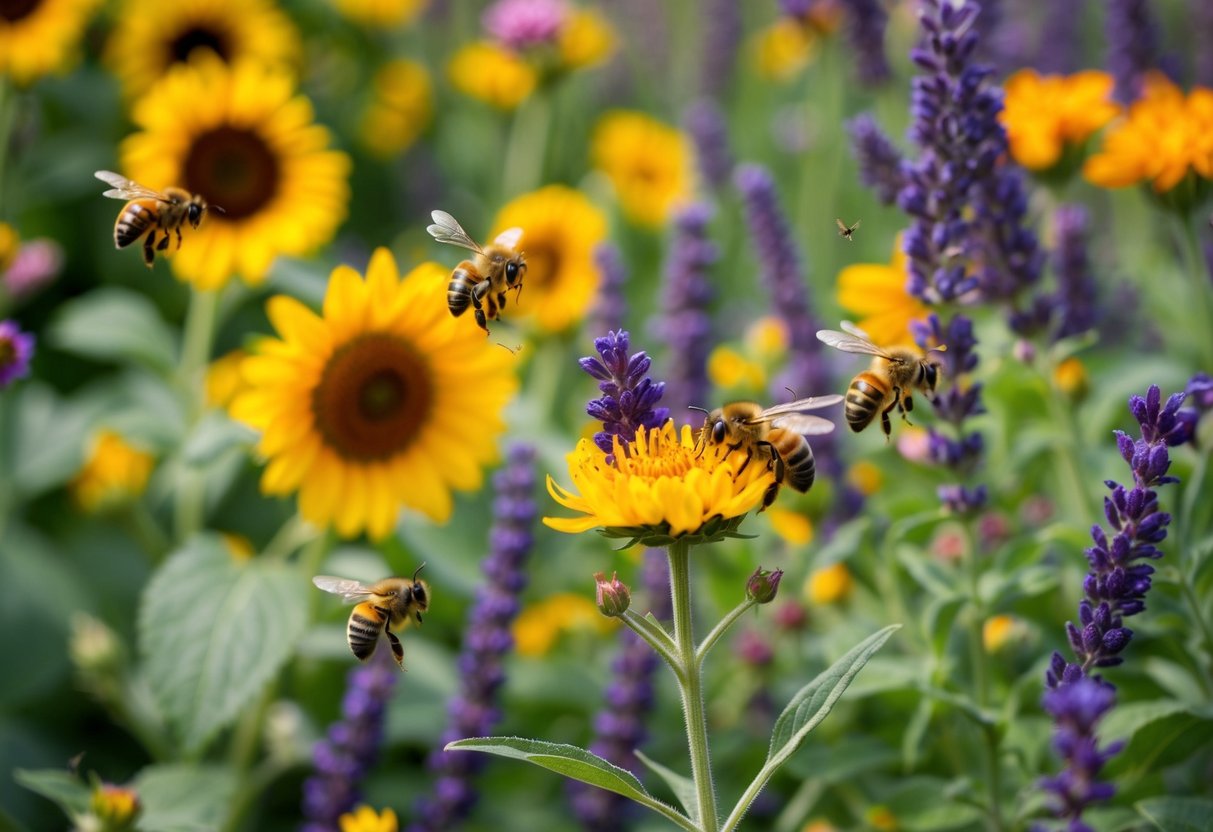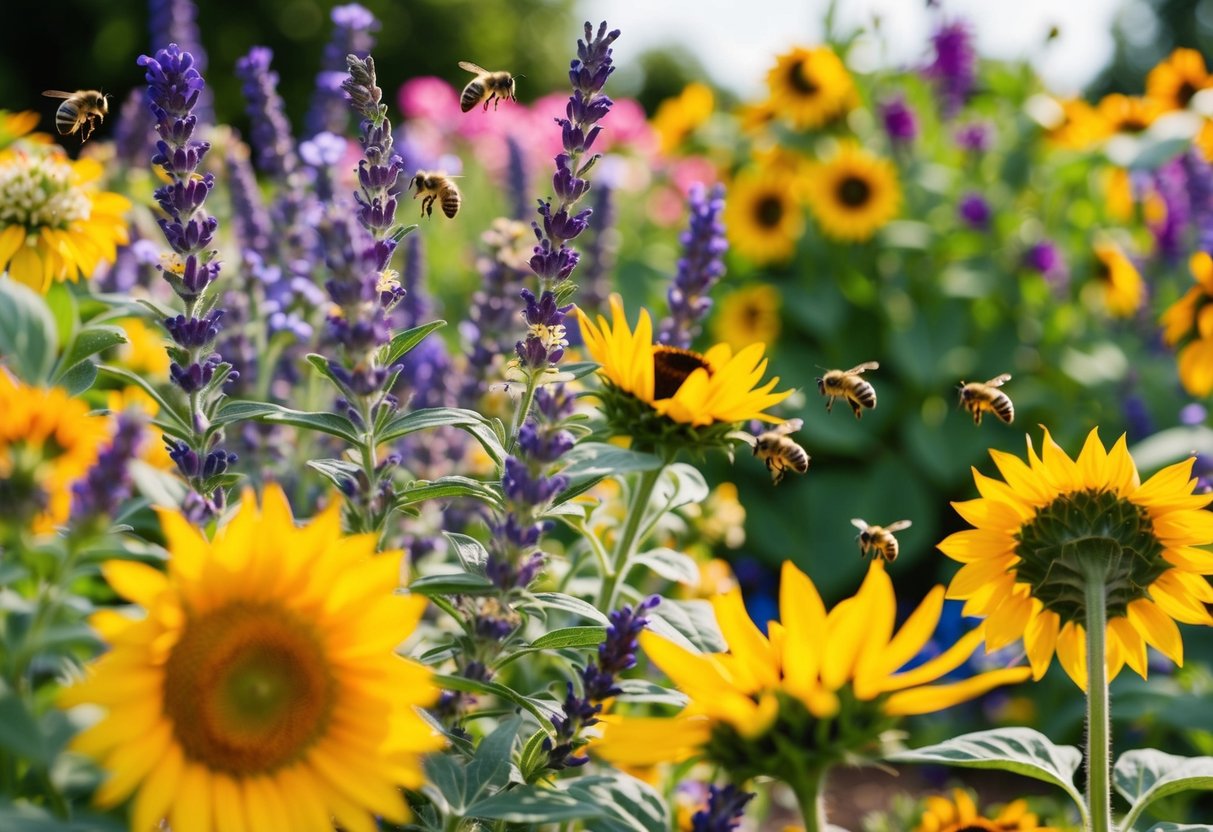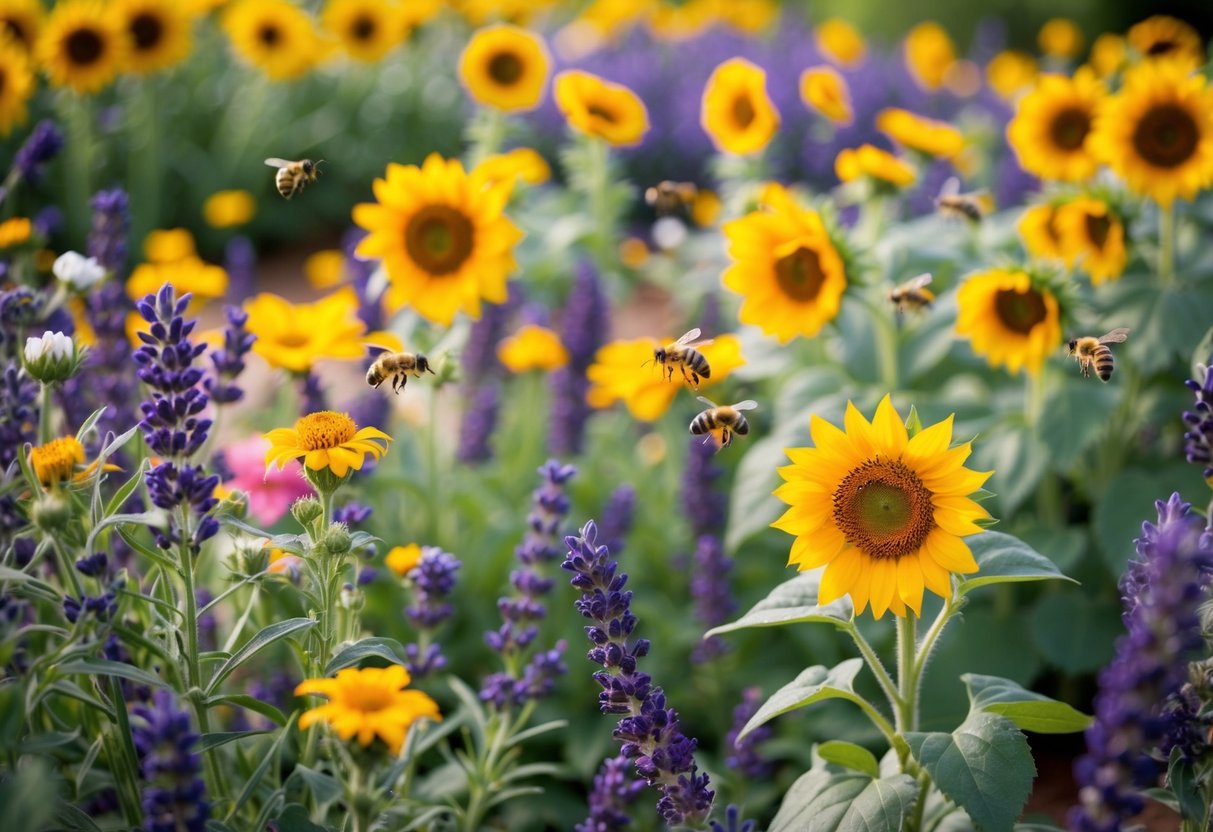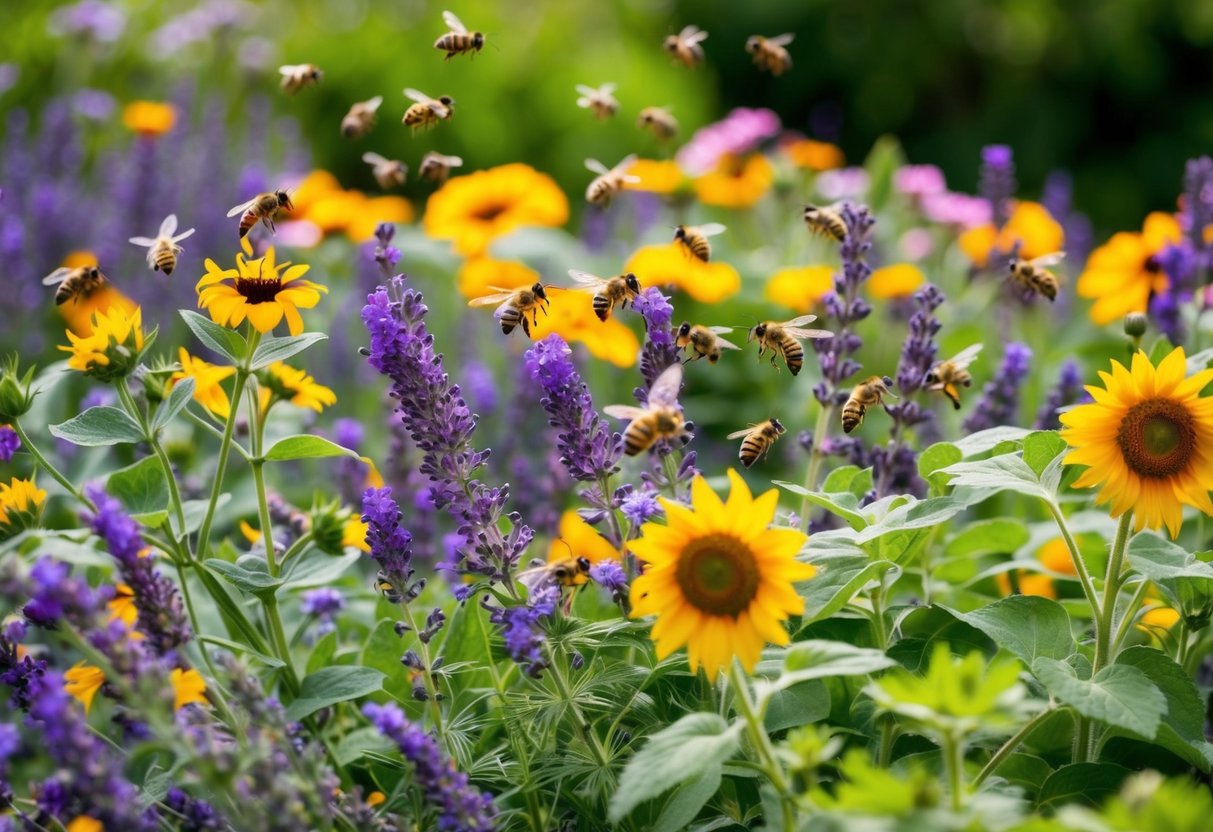Which Flowers Do Bees Like Best? Top Picks for a Bee-Friendly Garden
If you’ve ever watched bees buzzing around your garden, you’ve probably seen them make a beeline for certain flowers. Bees are drawn to blossoms rich in pollen and nectar, such as sunflowers and bee balm. These plants provide essential food sources for these vital pollinators.

You might be wondering what makes a flower attractive to bees. Generally, bees love flowers with bright colors and sweet scents, such as the vibrant calendula, which thrives in various conditions and offers plentiful pollen and nectar. Grouping flowers together in your garden also helps make it easier for bees to find a feast.
Choosing the right flowers for your garden can boost bee populations and enhance your garden’s beauty. Learning about which blossoms bees favor helps you create a buzzing, lively garden space. From lavender’s classic allure to the hardiness of catmint, your garden can become a haven for bees searching for their next meal.
The Importance of Bees as Pollinators

Bees play a crucial role in pollination, helping many plants reproduce by carrying pollen from one flower to another. Their work is vital for the growth of fruits, vegetables, and other crops, which supports entire ecosystems and human agriculture.
Understanding Bee Behavior and Preferences
Bees, including honeybees, bumblebees, and various native bees, are particularly attracted to certain types of flowers. The morphology of a flower and a bee’s ability to access its nectar significantly influence their interaction. Different bees have varying tongue lengths, which determines their preference for particular flowers. For instance, short-tongued bees prefer flowers with easily accessible nectar like daisies and sunflowers.
Bee behavior is also influenced by the time of day and environmental conditions. Bees are more active during sunny days and in warmer weather, as these conditions enhance their ability to find and collect nectar. Understanding these behaviors can help you attract bees by planting a variety of bee-friendly flowers in your garden, thus supporting pollination.
Benefits of Bees to Ecosystems and Crops
Bees are essential pollinators for many crops, including fruits and vegetables. About 75% of crop plants rely on animal pollination, and bees are among the most important animals in this process. They help increase crop yields by improving the quantity and quality of the produce, directly impacting food supply.
In natural ecosystems, bees contribute to the reproduction of wild plants, maintaining biodiversity and supporting wildlife. Their pollination activities ensure that plants can produce seeds and fruit, which serve as food sources for other animals. By supporting bee populations through gardening practices or conservation efforts, you help preserve vital ecological processes.
Preferred Flowers for Bee Pollination

Bees are drawn to specific flowers that provide them with ample nectar and pollen. Choosing the right plants can enhance your garden’s ability to attract these vital pollinators.
Characteristics of Bee-Friendly Flowers
To attract bees, pick flowers that are rich in nectar and pollen. Flowers with bright colors like blue, purple, and yellow are particularly appealing to bees.
Simple or open-shaped blossoms, such as those of the coneflower and sunflower, make it easier for bees to access the pollen and nectar. Fragrant plants like lavender and mint are also popular because their scent helps guide bees to them.
Some flowers, like bee balm and asters, have multiple tiny florets, which make for efficient feeding.
Annuals and Perennials that Attract Bees
Annuals, such as zinnia and calendula, provide continuous blooms from spring through fall. They are easy to grow and offer diverse colors and shapes that keep bees coming back. Annuals will need to be replanted each year, but their vivid appearance is worth it.
Perennials like black-eyed susan and goldenrod are low-maintenance and return year after year. Other perennial favorites include milkweed, catmint, and the vibrant New England aster. These plants create stable habitats for bees, helping them thrive throughout the seasons.
Creating a Bee-Friendly Garden

To create a bee-friendly garden, focus on selecting plants suitable for your area and offering a safe space for bees. The right plants and an environment free of threats can help attract and support various bee species.
Choosing the Right Plants for Your Region
When creating a bee garden, consider your climate and hardiness zones. Choose plants that thrive in your region and are known to attract pollinators like bees. Native plants are often a great choice as they are well-adapted to local conditions and require less maintenance.
Sun exposure matters too. Most bee-friendly flowers need full sun, at least 6 hours a day. Look at flower colors as bees are attracted to bright colors like blue, purple, and yellow. This can enhance the draw of your pollinator garden.
It’s also wise to pick drought-tolerant plants if you’re in a dry area. Plants like lavender and coneflowers can withstand heat and conserve water, making life easier for both you and the bees. Visit sites on the best flowers for bees to learn more about choosing the right species.
Providing a Safe Habitat for Bees
Creating a bee garden involves keeping it safe. Avoid using pesticides, as they can harm bees and other beneficial insects. Opt for natural pest repellents to manage unwanted visitors without impacting bee species.
Adding water sources like a shallow dish with stones can give bees a place to drink and rest. Mix in some flowering herbs such as mint or oregano for added attraction and fragrance. These plants can also handle varied conditions.
Diverse plantings with overlapping blooming periods ensure there’s always something in bloom from spring to fall. This continuous food supply helps various bee species thrive. Consider planting different types of flowers to provide nectar and pollen throughout the year. For detailed guidance on making your garden a bee haven, check out these bee garden tips.
Additional Plants that Support Bee Health

There are many wonderful plants that help sustain bee health. From herbs and shrubs to wildflowers, each offers nectar and pollen that bees need to thrive.
Herbs and Shrubs Bees Love
When planting herbs, consider adding sage, oregano, and rosemary to your garden. These herbs are aromatic and rich in nectar. Bees love thyme, especially when it blooms. Anise hyssop and borage also attract bees with their beautiful blooms and enticing scent.
If you’re looking for a pretty garden addition, include chives and hyssop. The purple flowers of chives not only look good but also attract bees. Meanwhile, allium provides a burst of color and attracts various pollinators.
Wildflowers and Native Varieties
Penstemon is a striking addition to any garden, known for its tubular flowers that bees find irresistible. You might also try lupine, which adds a splash of color while supporting pollinators. For something a bit different, plant cosmos and cleome for their bright and inviting flowers.
Snapdragons are another excellent choice, offering tall spikes of color that bees visit frequently. Don’t miss out on coreopsis, which blooms persistently and attracts pollinators. Baptisia is a lesser-known native plant but is particularly beneficial in supporting bee populations.
The Relationship Between Bees and Larger Flora

Bees play a vital role in supporting the growth of various flora by transferring pollen from one plant to another. This relationship benefits both the bees and the plants, contributing significantly to ecological health and biodiversity.
Trees and Shrubs that Provide for Bees
Trees and shrubs are important sources of nectar and pollen for bees. They offer food and shelter throughout different seasons. Trees like maples and willows bloom early, offering food in the spring when other plants may not be available. Shrubs such as the joe pye weed attract many bee species, including long-tongued bees, by providing nectar in late summer.
These larger plants also contribute to the natural beauty of landscapes. Trees and shrubs create a diverse environment where bees can thrive. The great blue lobelia is a favorite for bees, providing resources essential for producing honey. By including such plants in gardens or natural areas, you can support bee populations and enjoy vibrant outdoor spaces.
Fruit and Nut Plants that Benefit from Bees
Fruit and nut plants not only rely on bees for pollination but also enhance our diets and the local ecosystem. Bees help in the pollination of plants like blackberries, nuts, and other berries. When bees visit flowers on these plants, they transfer pollen, leading to fruit and seed production.
Pollinated fruit plants produce more abundant and healthier fruits. This benefits both humans and wildlife, providing food for animals and feeding people. Besides contributing to food security, the presence of bees boosts the quality of harvests. Including plants like these in your garden helps maintain biodiversity and ensures that you enjoy fresh fruits and nuts. This symbiotic relationship is crucial for ecosystems to thrive.







